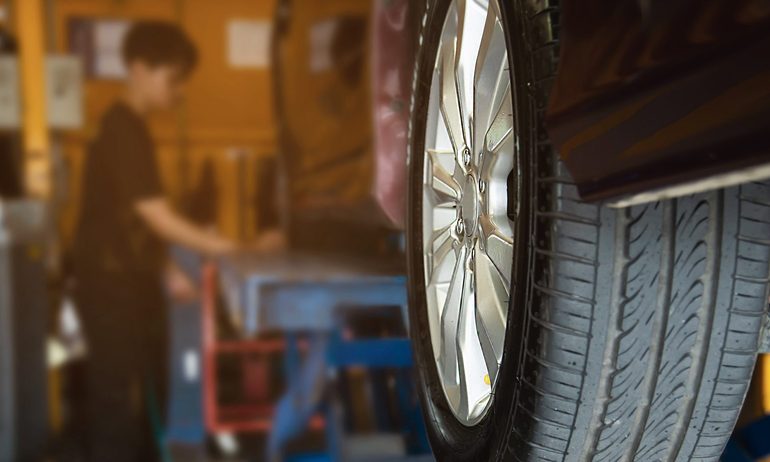How Big Wheels Cost You Big Time at the Pump
Big wheels and tires can add pizazz to your car, but they aren't the best option for your wallet.

Many, or all, of the products featured on this page are from our advertising partners who compensate us when you take certain actions on our website or click to take an action on their website. However, this does not influence our evaluations. Our opinions are our own. Here is a list of our partners and here's how we make money.
Choosing big wheels for your new car — or buying larger rims for your daily driver — will cost more, decrease gas mileage, provide a harsher ride and be harder to replace if damaged. Why would anyone want them?
“It’s mainly fashion,” says Mark Holthoff, senior editor at online used-car retailer Carvana. “There is a small performance gain that the average driver wouldn’t really notice — but a lot of downsides that you would notice.”
“Big, sexy wheels is an easy way to stand out,” says Josh Sadlier, director of content strategy at auto site Edmunds. “It’s become an arms race, and everyone’s doing it.”
Over half of the 496 models for 2022 have at least two wheel sizes available, according to Karl Brauer, analyst for car research site iSeeCars.com. Bigger wheels come with the more expensive models or they are included in packages that bundle a number of options together. “This essentially means you can’t buy the most expensive, best-equipped version of most cars without also getting larger wheels,” he says.
Whether you’re choosing options for your new car, or thinking of “plus-sizing” the wheels on your car or off-road vehicle, there are a lot of trade-offs to consider.
More rubber meets the road
Bigger wheels mean that the tire’s “contact patch,” the part touching the pavement, is larger.
That creates more grip, but it also creates more rolling resistance, making the motor work harder. Additionally, larger wheels are heavier, putting more strain on the brakes and suspension components. In some cases, according to a Car and Driver study, larger rims make braking distances longer and acceleration slower.
But you’ll notice the effects of big wheels most at the pump or charger.
A clear illustration of the drag on fuel economy is seen by comparing two wheel sizes in the same car. For example, the 2022 Toyota Prius Eco gets a combined 56 mpg on its standard 15-inch wheels and tires. On the flip side, the 2022 Prius XLE, with the same engine and transmission but larger wheels and tires, gets 50 mpg combined.
In electric vehicles, the effect of larger wheels is more dramatic. The 2022 Tesla Model S Plaid with 19-inch wheels delivers 396 miles of range, and the same car with 21-inch wheels provides 348 miles of range. That’s more than a 12% reduction for an option that costs $4,500.
Of course, it's not the diameter of the wheel itself that hurts mileage; it's the increased weight of bigger wheels and higher rolling resistance of grippier tires that take a toll.
Watch out for potholes and curbs
For most passenger cars used on paved roads, the goal of bigger wheels is to fill out the wheel wells for a more muscular look. The total diameter of the wheel and tire should stay the same to keep the odometer and speedometer accurate — but that means as wheels get bigger, tires get thinner. These are called low-profile tires.
Low-profile tires cause a number of problems:
They are more easily damaged by potholes since the tire’s rubber sidewall is more easily pinched between the pavement and the edges of the wheels.
Without a bulging sidewall to protect them, these wheels are easily "curbed" and scratched.
Handling in rain and on loose surfaces suffers, according to the Car and Driver study.
Low-profile tires are more expensive to replace. The 19-inch tires on the 2022 Tesla Model S Plaid cost about $1,769 a set, while 21-inch tires are $2,003, according to TireRack.com, an online tire seller.
To upsize your wheels and still stay within the manufacturer’s recommendations, use a tire size calculator on tire retailers’ websites. And if you buy low-profile tires, look for those with a “rim protector” — a raised strip of rubber that guards against curb rash — or consider looking for wheel and tire insurance. The cost of five-year coverage can be as little as $500 to more than $2,000.
Going off road
Buying special tires to explore the outdoors usually means buying larger, heavier sizes that are puncture resistant and have deeper tread. But if off-roaders choose a tire size bigger than the manufacturer’s recommendation, it can drastically affect fuel economy and make the speedometer and odometer readings inaccurate.
Some off-road experts estimate the loss in fuel efficiency as high as 5% to 10%. That’s a trade-off many are willing to make.
Holthoff says when he swapped out the factory tires on his 2002 Mercedes ML500 for off-road tires, his fuel economy went from 13/19 mpg city/highway to roughly 10/16 mpg.
If you know that you will spend 90 percent of your time on pavement, an all-terrain tire would be your best fit, advises Off-Road.com, rather than a much more aggressive mud tire.
Weigh the options and the costs
“Larger wheels aren’t always a bad idea,” says iSeeCars’ Brauer. “But consumers should consider how they’ll utilize their vehicle before committing to larger diameter wheels.”
Here are a few questions to ask yourself to guide you to the right choice:
Will you really be going off-road and need those big, knobby tires?
Do you live in an area where the roads are rough and you’re likely to be hitting potholes?
Will you often have to parallel park and risk curbing the wheels?
Are you willing to buy tire-and-wheel insurance or pay out-of-pocket to have scratches removed from the rims?
And, finally, will larger wheels really improve the look of your car enough to justify all the related expenses and issues?


